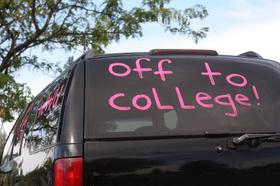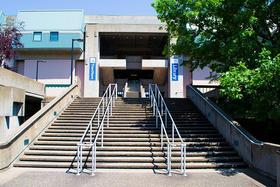- As an urban community college serving primarily the southwest metropolitan region of the Twin Cities, Normandale prepares students for full participation in our diverse communities, creates pathways to other college programs, and builds community connections.
School Highlights
Normandale Community College serves 13,957 students (27% of students are full-time).
The college's student-teacher ratio of 30:1 is higher than the state community college average of 22:1.
Minority enrollment is 54% of the student body (majority Black and Hispanic), which is more than the state average of 42%.
Quick Facts (2025-26)
- Enrollment: 13,957 students
- In-state tuition: $5,709
- Out-state tuition: $5,709
- Student-teacher ratio: 30:1
- Minority enrollment: 54%
- Source: Integrated Postsecondary Education Data System (IPEDS)
Top Rankings
Normandale Community College ranks among the top 20% of public schools in Minnesota for:
School Overview
The teacher population of 459 teachers has stayed relatively flat over five years.
Normandale Community College
(MN) Community College Avg.
Carnegie Classification
Associate's Colleges: High Transfer-High Nontraditional
Associate's Colleges: Mixed Transfer/Career & Technical-Mixed Traditional/Nontraditional
Institution Level
At least 2 but less than 4 years
At least 2 but less than 4 years
Institution Control
Public
Public
Total Faculty
459 staff
171 staff
School Calendar
Student Body
The student population of Normandale Community College has grown by 43% over five years.
The student-teacher ratio of 30:1 has increased from 21:1 over five years.
The Normandale Community College diversity score of 0.71 is more than the state average of 0.63. The school's diversity has grown by 9% over five years.
Total Enrollment
13,957 students
2,858 students
Student-Teacher Ratio
30:1
22:1
# Full-Time Students
3,738 students
1,050 students
# Part-Time Students
10,219 students
1,808 students
# Enrollment Undergraduate
139 students
420 students
# Full-Time Undergraduate Students
3,738 students
915 students
# Full-Time Graduate Students
n/a
38 students
# Part-Time Undergraduate Students
10,219 students
1,771 students
# Part-Time Graduate Students
n/a
12 students
Total Dormitory Capacity
n/a
116 students
% American Indian/Alaskan
n/a
1%
% Asian
9%
6%
% Hispanic
11%
8%
% Black
20%
15%
% White
46%
58%
% Hawaiian
n/a
1%
% Two or more races
5%
4%
% Non Resident races
1%
1%
% Unknown races
8%
6%
Diversity Score
0.71
0.63
College Completion Rate (Students who graduate in less than 4 years)
19%
34%
College Completion Rate (Students who graduate in 4 years or more than 4 years)
n/a
57%
Average Graduate Earnings (10 Years)
$40,100
$36,900
Tuition and Acceptance Rate
The public in-state tuition of $5,709 is more than the state average of $5,489. The in-state tuition has stayed relatively flat over four years.
The public out-state tuition of $5,709 is less than the state average of $6,145. The out-state tuition has stayed relatively flat over four years.
In-State Tuition Fees
$5,709
$5,489
Out-State Tuition Fees
$5,709
$6,145
% Students Receiving Some Financial Aid
93%
89%
Median Debt for Graduates
$12,750
$12,264
Median Debt for Dropouts
$6,752
$6,750
Acceptance Rate
n/a
94%
SAT Reading
n/a
625
SAT Math
n/a
600
SAT Writing
n/a
565
ACT Composite
n/a
24
ACT English
n/a
24
ACT Math
n/a
23
ACT Writing
n/a
8
Source: 2024 (or latest year available) Integrated Postsecondary Education Data System (IPEDS)
School Notes
- Normandale Community College is an urban two-year college serving primarily the communities of the southwestern metropolitan region of the Twin Cities. Established in 1968, the college is accredited by the Higher Learning Commission of the North Central Association of Colleges and Schools. More than 10,000 students from diverse backgrounds take courses at the college annually. Our career programs prepare students for full employment in fields such as Dental Hygiene, Nursing, Business, Mechanical Engineering Technology, Hospitality Management, Law Enforcement, Dietetics, Computer Technology, Accounting and many other areas. We offer developmental courses designed to improve academic skills required for successful performance in college-level courses. Continuing education and customized training opportunities are provided through a variety of non-credit courses offered through the Normandale Center for Opportunity. Normandale Community College will serve as a regional higher education center, working closely with its communities to meet changing needs through innovative and responsive programs and quality teaching. We will inspire learners to develop skills and interests that will enrich their lives and shape their futures.
Frequently Asked Questions
How much does Normandale Community College cost?
Normandale Community College's tuition is approximately $5,709 for In-State students and $5,709 for Out-State students.
What is Normandale Community College's ranking?
Normandale Community College ranks among the top 20% of community college in Minnesota for: Diversity in US community colleges and Largest student body.
In what neighborhood is Normandale Community College located?
Normandale Community College is located in the West Bloomington neighborhood of Bloomington, MN.
Recent Articles

The Rise of Technical and Vocational Training in 2025
Explore the 2025 surge in technical and vocational training—enrollment, policy, costs, and why this path is gaining ground for students and parents.

Stackable Credentials: How Community Colleges Advance Careers
Discover how community colleges use stackable credentials to build career pathways, boost earnings, and enable lifelong learning in 2025.

High-Paying Jobs You Can Get with a Community College Degree
Discover top high-paying careers you can launch in 2025 with a community college (associate) degree and high-growth credentials in tech, healthcare and trades.











